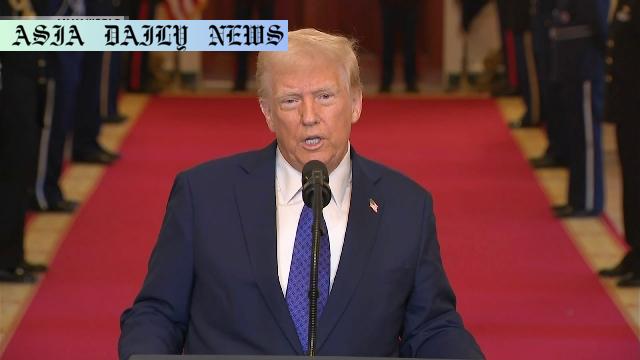Trump’s second term highlights dramatic shifts, from economic policies to international relations, leaving a controversial impact.
Trump’s second term sees 171 executive orders passed in 6 months.
US faces controversial changes in trade, international relations.
Domestic policies focus heavily on immigration, budget cuts.
Approval ratings drop slightly, public backlash evident.

Analyzing Trump’s Initial Six Months of His Second Term
The first six months of Trump’s second term as U.S. President have been anything but conventional. Marked by a combination of aggressive domestic policies and assertive foreign policies, Trump’s actions reflect a clear continuation of his “America First” agenda. However, with controversy being its hallmark, this term’s features include unprecedented executive orders, heated trade negotiations, and a crackdown on immigration, further cementing Trump’s distinctive governing style.
Having signed 171 executive orders in just six months, Trump has already exceeded the number signed by his predecessor Joe Biden in four years. Notable among these orders are directives aimed at cutting federal spending, reducing federal workforce numbers, and increasing national security measures—all of which have sparked varying reactions domestically and abroad.
Disruptive Trade Policies Take Center Stage
Trade policy is a defining factor of Trump’s second term. Tariff threats remain at the forefront of negotiations, especially with countries like Japan. The U.S. president openly criticized Japan over trade imbalances tied to automotive imports, threatening to impose a 25% tariff on Japanese cars by August. This aggressive stance on trade is a continuation of his first term approach—prioritizing American industries and protecting their interests while reducing the deficit.
In addition, Trump has intensified his dissatisfaction with NATO, clearly stating the burden placed on U.S. defense contributions. By pressuring the NATO summit last month, his administration achieved a controversial commitment for members to increase their defense spending to 5% of their GDP. Whether this move reflects progress or strain in international alliances remains up for debate.
Russia and Ukraine Relations: Strengthening Diplomacy Amid Strain
On the foreign policy front, Trump’s handling of the ongoing Russia-Ukraine military conflict has attracted significant media attention. Tensions with Ukraine’s President Zelenskyy culminated in a widely publicized argument at the White House. Despite this, Trump has recently ramped up diplomatic pressure on Russia, aiming for a ceasefire in the ongoing crisis. Analysts are divided on whether this represents a constructive shift or complicates the already tense bilateral relations further.
Immigration Crackdown Sparks National Debate
Domestically, Trump has maintained a consistent hardline stance on illegal immigration. Notably, Los Angeles recently witnessed widespread protests against the administration’s federal crackdown, which resulted in the deployment of the National Guard. Critics, including the Mayor and Governor, argue this action escalated tensions rather than stabilizing them. However, Trump’s base has lauded this move as a vital part of preserving national security.
Additionally, Trump has enforced budget cuts and extensive federal workforce reductions, aiming to limit government spending. These actions are controversial but align with promises he made before his initial presidential victory.
Approval Ratings and Future Economic Implications
President Trump’s approval ratings have seen a moderate decline. In January, 50.5% of respondents approved of his presidency while 44.3% disapproved. By March, these figures reversed. Analysts blame this trend on the polarizing nature of his policies and public dissatisfaction with persistent controversies.
However, despite the backlash, Trump’s team points to a steady economy as a vital factor mitigating potential damage to his approval ratings. Experts warn, though, that his aggressive tariff policies may soon begin to impact economic vitality, potentially harming consumer sentiment.
Commentary
A Transformative Yet Controversial Milestone for Trump
Trump’s second term in office has set a precedent for the strategies and direction of his administration—one filled with boldness, unexpected pivots, and intense public reactions. His actions, while divisive, continue to reflect an unrelenting push to reshape America, both domestically and on the world stage.
Massive trade realignments, such as proposed tariffs on major trading partners, showcase Trump’s absolute commitment to America First policies. However, the long-term implications of such policies risk creating economic strain on average American workers and industries dependent on imports. The efficacy of these measures in reducing trade deficits remains uncertain, making them a high-stakes gamble.
Balancing National Security With Domestic Unity
Equally significant are the domestic crackdowns, which have ignited debates over human rights, security, and national identity. The protests in Los Angeles underline the layers of frustration brewing within the country. While Trump staunchly defends his policies, citing safety and budget reformation benefits, these moves have left a trail of dissent.
This polarizing trajectory is reflected in his approval ratings. While steadied by an ostensibly strong economy, Trump risks losing public favor should negative impacts of these widespread policies materialize in the near future.
Lessons From Six Controversial Months
Overall, the first six months of Trump’s second term are both a testament to his capacity for transformative policymaking and a cautionary tale of overreach. Nonetheless, these bold political maneuvers ensure that Trump’s legacy will forever serve as both an example of radical leadership and a reminder of the fine balance required in addressing modern socio-economic challenges.


